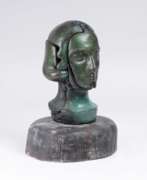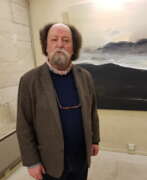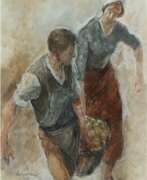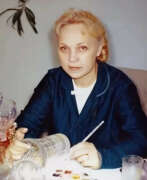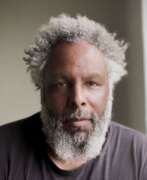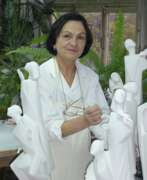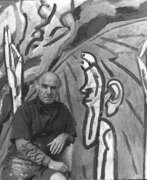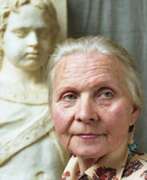Genre painters 21st century


Alexander Grigorievich Maksymenko (Russian: Александр Григорьевич Максименко) was a Soviet and Ukrainian painter of the second half of the twentieth and early twenty-first centuries. He is known as a painter, graphic artist, watercolorist, and art historian.
Alexander Maksymenko worked in the genres of still life, landscape, portrait, as well as in genre painting. His genre works cover themes of collective farm life, including "Masters of the Land" and "Innovators of Collective Farm Fields". For the latter work he received the Stalin Prize. The master actively participated in exhibitions in Ukraine and abroad. His works are in the National Art Museum of Ukraine, the Museum of the History of Ukraine in World War II, as well as in other art museums and private collections.


Sultan Shamsutdinovich Abaev (Russian: Султан Шамсутдинович Абаев), a Chechen and Russian artist born on November 1, 1954, in Khaidarkan, Soviet Union, is celebrated for his distinctive contributions to landscape art. A member of the Artists Unions of Saint Petersburg and the Chechen Republic, Abaev's work exemplifies his profound connection to his cultural roots and the rich landscapes that inspire him.
Educated at the prestigious Repin Institute of Painting, Sculpture, and Architecture in Saint Petersburg, Abaev has been honored multiple times for his artistic achievements, including receiving the title of Honored Artist of the Russian Federation. His works have been internationally recognized, finding places in private collections across countries such as Germany, the United States, and Japan.
Abaev's career also includes time spent abroad in Sri Lanka and South Korea from 1991 to 1993, where he expanded his artistic horizons and produced a series of paintings influenced by these experiences. Today, his works are sought after by collectors, especially those interested in landscapes and cultural narratives embedded in art.
Stay updated on exhibitions and sales related to Sultan Shamsutdinovich Abaev's enchanting landscapes by signing up for our exclusive alerts. These updates are essential for collectors and art connoisseurs interested in owning a piece of Chechen and Russian art history.




Victor Ashotovich Abramyan (Russian: Виктор Ашотович Абрамян) was a Soviet and Russian artist of the second half of the twentieth and early twenty-first centuries. He is known as a painter, a representative of the Leningrad school.
Victor Abramyan created portraits, landscapes, still lifes and genre paintings. He participated in exhibitions from the early 1970s in Leningrad. Among his famous works are "Blockade everyday life", "Still Life with a Centennial", "Leningrad. 1942. Women on Guard in the besieged city", "Young Guests" and others.
Abramyan's works are in museums and private collections in Russia and many other countries.


Angelo Accardi is a contemporary Italian artist. He grew up surrounded by both modern and traditional art. Although he studied fine art at the Art Academy of Naples, he never completed his training. Angelo Accardi illustrates surreal visions of everyday life under realistic backdrops of urban and natural landscapes. There is never a single meaning, but a whole story behind each painting. Ironic, striking, and playful, Accardi’s unique perspective and avant-garde style is a result of his diverse inspirations.


Vladimir Ivanovich Akulov (Russian: Владимир Иванович Акулов) is a Soviet and contemporary Belarusian artist. He is known as a painter, graphic artist and teacher, a representative of the second wave of Belarusian avant-garde.
Vladimir Akulov in his work has developed a unique style under the influence of expressionism, cubism, primitivism, fauvism. He is a master of portrait, landscape, still life, compositions with symbolic and allegorical subjects, illustrations of literary works. During his career the artist created several cycles of portraits, including those of famous people.


Ismail Al-Sheikhly is a contemporary Iraqui artist. He belonged to one of the first art groups to appear in Iraq, 'La Societe Primitive', founded in 1950. The group later changed its name to 'The Pioneers' and kept it into the 1970s. Some of his works are influenced by Cubism, a movement which grew in popularity throughout the 1950s, and was the preferred artistic style of one of Al-Sheikhly's important contemporaries, Hafiz Drubi. Al Sheikhly’s early works are inspired by the Iraqi village life, though his later works are more focused on abstracted colour combinations and obscured backgrounds. Women feature highly as a central theme in his work. Painted in groups quite often, Al Sheikhly’s women are streamlined with oval faces and generic bodies and seem to always be in states of coming and going, whether that be to the mosque, to the souks, or to do some domestic task.


Evgenia Petrovna Antipova (Russian: Евгения Петровна Антипова) was a notable Russian painter, graphic artist, and art teacher. She stood out for her genre compositions, portraits, landscapes, and still lifes, primarily utilizing oils and watercolors. Evgenia Antipova's works often depicted apple orchards and Crimean landscapes, showcasing her profound connection to nature and her ability to capture its essence.
Evgenia Antipova's education at the prestigious Repin Institute of Arts shaped her artistic journey, leading to a career enriched with personal exhibitions and a significant presence in the art community. Not only did her artworks gain recognition in Russia, but they also found their way into international collections and exhibitions, notably in France, Germany, the United States, and the United Kingdom.
Throughout her career,Evgenia Antipova was an active participant in various significant exhibitions, displaying her works alongside other renowned artists. Her contributions to the art world were recognized with personal exhibitions in Saint Petersburg and inclusion in art auctions and exhibitions abroad.
Evgenia Antipova's paintings are part of prestigious collections, including the State Russian Museum, and continue to be celebrated in art museums and private collections globally. Her legacy as a prominent figure in the Leningrad School of painting endures, captivating art enthusiasts and collectors with her vivid and emotionally resonant works.
For those interested in Russian art, particularly the Leningrad School of painting, Evgenia Petrovna Antipova's oeuvre offers a rich exploration of genre compositions and landscapes, reflecting the artistic vibrancy of her era. Collectors and art experts are encouraged to delve into her works and consider signing up for updates on exhibitions and sales featuring her paintings.


Sally Michel Avery is an American artist known for her paintings in the style of abstract expressionism. Her paintings are often associated with musical rhythm and melody. She began her career as a landscape painter, and in the 1940s she moved to more abstract forms and color schemes.
Avery was one of the few women recognized as influential in American abstract painting in the mid-20th century. Her work can be seen in museums and private collections around the world.


John Baeder is an American painter closely associated with the photorealist movement. He is best known for his detailed paintings of American roadside diners and eateries. His interest in small towns across America began when he was young by photographing old cars and other relics. He started working as an art director in Atlanta for a branch of a New York advertising agency in 1960, and subsequently moved to New York City in 1964. He went on to have a successful career in advertising through the early 1970s, while continuing to paint, draw and photograph on his own time. Baeder left the advertising field in 1972 to pursue his artistic career full-time. The same year, OK Harris Gallery in New York began exhibiting his artworks. Since then, he has had more than thirty solo exhibitions at art galleries. His work includes oil paintings, watercolors and photographs. Baeder’s work aims to chronicle the disappearing aspects of American culture. Baeder is the recipient of the Tennessee Governor's Distinguished Artist Award in 2009.


Irina Mikhailovna Baldina (Russian: Ирина Михайловна Балдина) was a Soviet and Russian artist of the second half of the twentieth and early twenty-first centuries. She is known as a painter, a representative of the Leningrad school.
Irina Baldina participated in exhibitions in Leningrad since 1952. Her work covered a variety of genres, including portraits, landscapes, still lifes and genre compositions. From 1960 to 1980, her works were characterized by themes of modernity, nature and people of Zaonezhye. Her style was characterized by broad brushstrokes, decorative and mastery in conveying the colors of northern nature.
Her works are in museums and private collections all over the world, including Russia, France, USA, Japan and other countries.
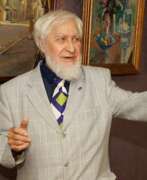

Yuri Vladimirovich Belov (Russian: Юрий Владимирович Белов) was a Soviet and Russian artist of the second half of the twentieth and early twenty-first centuries. He is known as a painter, a representative of the Leningrad school, who worked in the genres of portrait, landscape, still life and historical painting.
Yuri Belov actively participated in exhibitions since 1954. In 1960-1980 the main theme of his work was the images of Lenin and the history of the revolutionary movement. The artist's manner evolved from strict objectivism to a more decorative and impressionistic style.
The master's works are in museums in Russia, France, the USA, Germany and other countries, as well as in private collections.




Francois Boisrond is a contemporary French painter. He studied from 1977 to 1980 at the National School of decorative Arts. In 1981 he became involved in the Free Figuration movement. Inspired by visual products (advertising products, posters, stickers, video games etc.), cartoon characters, and by using acrylic paint, Francois Boisrond’s works are colourful, figurative and enigmatic, and his simplified shapes are often outlined in black. He portrays mainly characters, frequently symbolic in everyday situations, but he also depicts urban, maritime or rural landscapes. Besides this Boisrond creates humanitarian and publicity posters. Since the 1990’s the artist has become interested in an imaginary public and the everyday life that invades each and every one of us.
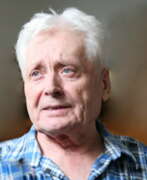

Vasily Pavlovich Borisenkov (Russian: Василий Павлович Борисенков) was a Soviet and Russian artist of the second half of the twentieth and early twenty-first centuries. He is known as a painter and teacher, a representative of the Leningrad school of painting.
Vasily Borisenkov actively participated in Leningrad art exhibitions since 1954, was the author of genre and battle paintings, landscapes and portraits. Among his famous works are the paintings "Difficult Conversation", "Spring", "Strelna. The Beginning of Summer" and many others. The master's works are in museums and private collections both in Russia and abroad.
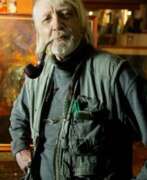

David Fielding Gough Boyd was an Australian artist, and a member of the Boyd artistic dynasty.
In 1946, he worked with his brother Guy at the Martin Boyd Pottery in Sydney. He also established a pottery studio in London in the early 1950s and continued working mainly in pottery through to the mid-1960s. In 1956, Boyd and his wife became widely known as leading Australian potters. They introduced new glazing techniques and potter's wheel use in shaping sculptural figures.
Boyd's painting career began in 1957 with a series of symbolic paintings on Australian explorers that aroused much controversy at the time, focusing as they did on the tragic history of the Aboriginal Tasmanians. In 1958 he exhibited a series of paintings based on the histological episodes in the explorations of Burke and wills and Bass and Flinders.[3] He joined the Antipodeans Group in the 1950s. Boyd discovered a technique in 1966 that he named Sfumato, after da Vinci's usage of the word to describe graduations of smoky tones in painting. Boyd's method achieved this effect through a new technique involving candle flame.


Gary Bunt is a British self-taught artist known for his paintings of the English suburbs and countryside. He took up art to overcome a serious illness. Gary Bunt in a primitive style, with sophisticated simplicity and good humor depicts ordinary life with its simple joys.


Deborah Kay Butterfield is an American sculptor. Along with her artist-husband John Buck, she divides her time between a farm in Bozeman, Montana, and studio space in Hawaii. She is known for her sculptures of horses made from found objects, like metal, and especially pieces of wood.


Zlata Nikolaevna Byzova (Russian: Злата Николаевна Бызова) was a Soviet and Russian artist of the second half of the twentieth and early twenty-first centuries. She is known as a painter, a representative of the Leningrad school, famous for her genre compositions, portraits, landscapes and studies from life.
Zlata Byzova achieved particular success in provincial portrait-types and Old Ladoga sketches of the 1960s-1970s. Her works were successfully presented at exhibitions and auctions of Russian painting in France in 1989-1992.
The artist's works are in museums and private collections in Russia, Finland, Germany, France and other countries.






Tom Christopher is an American painter known for his New York City urban paintings and murals. Most of the work is painted using small-batch, handmade acrylic paint. Pencil lines from the initial exploratory sketch stage often remain on the white canvass. His typical images include cabbies, delivery men, skylines, and chaotic city scenes. His work is usually done with acrylic paint in an expressionist style. Christopher began as a commercial artist, and has become a painter with worldwide galleries and exhibitions. He has also experimented with collage-style paintings and silkscreens that utilize multiple images and layers.


Gregory Crewdson is an American photographer. He photographs tableaux of American homes and neighborhoods.
Crewdson's photographs are elaborately staged and lit using crews familiar with motion picture production and lighting large scenes using motion picture film equipment and techniques. Using shots that resemble film productions, Crewdson deconstructs American suburban life in his work.


Ray Austin Crooke was an Australian artist known for for serene views of Islander people and ocean landscapes, many of which are based on the art of Paul Gauguin. He won the Archibald Prize in 1969 with a portrait of George Johnston. His painting The Offering (1971) is in the Vatican Museum collection. Many of his works are in Australian galleries. He was made a Member of the Order of Australia in the 1993 Australia Day Honours, "in recognition of service to the arts, particularly as a landscape artist".


Georg Dinz is a contemporary Austrian artist. After studying at the Vienna University of Applied Arts, Dienz lives and works as a room and stage designer in the Viennese punk scene. Shortly after the fall of the Wall, Dienz moves to Berlin, where he takes part in various art projects in the wild post-reunification period. Today he concentrates on free painting in his studio in the former Berlin artist district of Prenzlauer Berg. Georg Dienz's works are stylistically characterized by a flat and clear application of paint and can be described as "reduced realism".
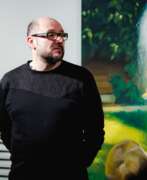

Vladimir Efimovich Dubosarskii (russian: Владимир Ефимович Дубосарский) is a Russian artist. From 1994 to 2014 he worked in an art duo with Aleksandr Vinogradov (russian: Александр Виноградов).
He studied at the Moscow Art College in memory of 1905, then at the Moscow State Art Institute named after V. I. Surikov. Since 1994, a member of the MOSKh, corresponding member of the Russian Academy of Arts.


Hamed Ewais is an egyptian artist. Ewais graduated from the Cairo’s School of Fine Arts in 1944, later he continued his studies at the Royal Academy of Fine Arts of San Fernando in Madrid, returning to teach at the Faculty of Fine Arts in Alexandria. Ewais was of the founders of the Group of Modern Art in 1947 along with several artists. In 1956, he was awarded the Guggenheim International Prize. Influenced by key figures of Mexican muralism such as Diego Rivera and David Alfaro Siqueiros, Ewais chose to work in an aesthetic style that reflected his socialist political leanings. As one of Egypt’s leading social realist painters, Ewais highlighted the plight of the country’s working class and was a proponent of Nasser’s Pan Arab movement.




Alfred Fritzsching is a German artist known as Painter, graphic artist, draftsman, sculptor, commercial, commercial graphic artist. He began his training as a commercial graphic artist at the Blocherer School for Graphic and Advertising in Munich and worked as an advertising specialist. In 1970 Alfred Fritzsching became a member of Munich Artists 'cooperative and participated in exhibitions at the Haus der Kunst in Munich. From 1978, he worked as a freelance painter and also as board member and juror of the Munich Artists' Cooperative.


Albin Stanislavovich Gavdzinsky (Russian: Альбин Станиславович Гавдзинский) was a Soviet and Ukrainian artist of the second half of the twentieth and early twenty-first centuries. He is known as a painter, famous for his landscapes, genre paintings and portraits.
Albin Gavdzinsky in the early 1950s held his first solo exhibitions in Odessa, Kiev and Kharkov and showed his bright artistic personality. The artist was distinguished by his outstanding efficiency and precision in depiction, which was evident in his clear forms and bright colors. In 1961 he was recognized as Honorary Citizen of the city of Novaya Kakhovka, and his works (237 canvases) served as the basis for the creation of the city's art gallery, which in 2003 was named after him.


Franz Gertsch is one of Switzerland's most outstanding contemporary artists. Throughout his career, he has produced a wide range of paintings and graphic works in which he tries to find a particular approach to reality. Although the author uses photographs or slide projections as his starting points, the paintings adhere to a logic of their own which seeks the correctness of all elements. Woodcuts also occupy a special place in Franz Gertsch's work.


Antonio Gravina was an Italian painter. He was born in Naples and studied at the Art Institute in that city. The setting, the chromatic range, makes his work a valuable item to collectors the world over. His subjects are hugely varied. Quiet bays bathed in sunlight, the fishermen carefully mending their nets, the transparent emerald sea reflecting the clear sky; or his paintings of stormy seas, portrayed with vivid, essential, sharp brush strokes, those heavy grey skies warning of an imminent storm. Unforgettable too, his restful spring time parks, his characteristically colourful Parisian bistro customers, his sunny cottage scenes with their softness and warmth. All his paintings bring to mind the masterpieces of the great 18th century artists, and yet his work is very much of the 21st century. He has had 48 exhibitions in Rome, Naples, Frankfurt, Sydney and Vancouver as well as occasional ones at Stewart Gallery in England.


Haddad Maurice is a contemporary painter from South Iraq. Encountering the work of Haddad Maurice for the first time, one can not help noticing the diversity of his compositional approaches, his media and materials. There are water color paintings that at first sight seem almost conventional, but that bear witness to an awareness of country life, sharp observation, an ability to catch moods. The works showing Iraqi women, real beauties, one might say, are close to folk art: bright, colorful, geometrical, and basically well-balanced in their formal language that relies on curves, segments of circles intercutting each other. Some works are mythological both in their formal language and their historical reference. In the case of these works, often wood instead of canvas is used as a surface.


Bahram Hajou is a Kurdish painter whose works can be classified as Neo-Expressionism. He lives and works in Münster as a freelance artist. In 1974 Bahram emigrated to Germany, where he studied at the Münster Art Academy from 1978 to 1984. Since 1981 he has taken part in exhibitions at home and abroad.


Robert Hammerstiel, an Austrian painter and engraver born on 18 February 1933 in Vršac, Yugoslavia, was renowned for his profound and impactful art. His works, deeply influenced by his experiences, were widely exhibited in prominent cities like New York, Vienna, Cairo, and Brussels.
Hammerstiel's journey in the art world was notable for its depth and variety. In 1988, he transitioned to a full-time artistic career, leaving behind his work in the steel industry. This shift marked a new phase in his life, allowing him to fully dedicate himself to his art. One of his significant works includes "Von Ikonen und Ratten: Eine Banater Kindheit 1939 – 1949," which comprises 32 woodcuts, highlighting his skill in both writing and visual arts. His talent was recognized with several prestigious honors, including the Austrian Decoration for Science and Art in 1998 and the Austrian State Prize for Graphics in 1973.
Hammerstiel's art was not just limited to traditional formats; in 2007, he impressively wrapped the Ringturm in Vienna with a 4,000 square meter painting. His works are a part of various collections and have been displayed in significant exhibitions. Notably, the Leopold Museum in Vienna featured his graphic work in an exhibition titled "Winterreise", inspired by Schubert's song cycle, showcasing a series of drawings and woodcuts.
Robert Hammerstiel's influence in the art world extended beyond his lifetime, culminating in his birth town dedicating a museum to his works in 2010. His passing on 23 November 2020 marked the end of an era but left behind a rich legacy that continues to inspire artists and art lovers globally. His work is a testament to the power of art in expressing the complexities of human experiences and emotions.
For collectors, auctioneers, and experts in art and antiques, the works of Robert Hammerstiel offer a unique blend of cultural richness and profound artistic expression. His art, characterized by its emotional depth and technical skill, continues to hold a special place in the world of fine arts.
To stay informed about exhibitions, sales, and auction events related to Robert Hammerstiel's art, sign up for updates. This subscription will keep you updated on new opportunities to engage with the work of this influential Austrian artist.
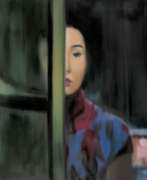

Wenjue He is a famous Chinese painter whose work is inspired by films. In the internationally acclaimed series, the viewer is presented with abstract emotions that are achieved with quick strokes that create a mystical aura. Themes from various films in Wenjue He's works include war, politics, human nature, eroticism and culture. They depict social events and historical changes, which are the most important criteria for the artist when choosing his films.




Sergey Israelovich Hovsepyan (Russian: Сергей Исраелович Овсепян) is a Soviet and contemporary Armenian artist. He is known as a painter working in different genres, but predominantly in portraiture and everyday life.
Sergey Hovsepyan began exhibiting his works in 1972. His work is distinguished by plastic diversity and aspiration to convey the actual problems of the time. He skillfully combines form and content, adjusting plastic principles to each theme. His large thematic paintings reflect an analytical and cognitive approach to the study of reality. The artist often introduces documentary material, photo and newsreel footage into his paintings.




Neil Jenney is a self-taught artist.
Jenney describes his style as realism, but it is an idiosyncratic use of the word on his part, meaning: a style in which narrative truths are found in the simple relationships of objects. His body of work during 1969–1970, which is the period for which he was first known, was a reaction to minimalism and photo-realism.


Aris Kalaizis is a German artist of Greek origin. He studied painting at the Leipzig Academy of Fine Arts.
Aris Kalaizis gained international recognition after taking part in the 2010 Venice Biennale (Mostra Internazionale di Architettura) and in the 4th Triennale in Guangzhou, China in 2011.
Calaisis creates his works by assembling elaborate spatial compositions and constructing large-scale scenes on the site of an imaginary action. In the process, he takes a series of preparatory photographs from which the final work is constructed. The scenes in his paintings, which often have a surrealistic impression, are developed from ideas that Kalaisis develops in the manner of a screenplay. The result of this step-by-step creative process are pictorial works that embody desired images of the inner world in line and colour.




Robert Edward Kennedy, an American artist born in Boston, is renowned for his evocative paintings and illustrations. His journey in art began at the Rhode Island School of Design, where he honed his skills in painting and illustration. Kennedy's art is deeply influenced by his travels across the Caribbean, Mexico, and Florida, where he captured the essence of these locales in his sketchbook and watercolors. His work is more than just art; it serves as a historical record, showcasing the vibrant streets, waterfronts, and popular pubs of America's colorful areas.
Kennedy's art is characterized by its meticulous detail and classic style, combined with a heartwarming flair. This unique blend has earned him a place as one of America's top-selling artists. His popularity is a testament to his ability to connect with art enthusiasts worldwide. Kennedy's contributions to the art world extend beyond his paintings. In 1968, he and his brothers opened their first studio in a 19th-century stable on Beacon Hill, Boston. By the mid-1980s, Kennedy Studios had expanded to 37 locations, from Kennebunkport to Key West. Bob Kennedy's role in this expansion was crucial, as he provided numerous drawings and watercolors that represented iconic East Coast landmarks.
A notable innovation by Kennedy in the art world was his coining of the term "giclee" in 1995. This term was used to describe the advanced inkjet fine art reproduction technique, a significant step forward from the traditional offset lithography of the time. This innovation reflects Kennedy's forward-thinking approach and his contributions to modernizing art reproduction techniques.
Among Kennedy's well-known works are his watercolor prints, such as "Make Way For Ducklings" and "Provincetown Sail." These pieces have been sought after in the art market, showcasing his skill in capturing the essence of American landscapes and scenes.
For collectors, auctioneers, and art and antiques experts, Kennedy's work represents a blend of traditional artistry with modern innovation. His paintings and prints are more than just visual experiences; they are journeys into the heart of American culture and history.
For those interested in the dynamic world of Robert Edward Kennedy's art, we invite you to sign up for updates. By subscribing, you'll be the first to know about new product sales and auction events related to Kennedy's work. Stay connected with us and don't miss out on the opportunity to explore and acquire pieces from one of America's most celebrated artists.




Oswald Kollreider is an Austrian painter. After completing his compulsory education, he apprenticed as a painter in Sillian. In 1940, he was drafted into the Wehrmacht and was severely wounded on the Eastern Front in 1943, losing two fingers on his right hand. Despite his disability, Kollreider passed the entrance exam for the Academy of Fine Arts in Vienna in 1944. He furthered his studies at the Mal- und Zeichenschule Toni Kirchmayr in Innsbruck and later at the Vienna Academy. Kollreider's works encompass portraits, particularly depicting the working class and rural life, as well as nudes, landscapes, floral paintings, and religious motifs in various mediums. He also created numerous public artworks, notably Sgraffito.


Pyotr Gurievich Korostelyov (Russian: Пётр Гурьевич Коростелёв) was a Soviet and Russian artist of the second half of the twentieth and early twenty-first centuries. He is known as a painter, a representative of the Leningrad school.
Pyotr Korostelyov participated in the Great Patriotic War, after demobilization he graduated from the Leningrad Art and Graphic School and taught art, continuing to be actively engaged in creative work. His works cover a variety of genres, including portraits, genre compositions, still lifes and landscapes. For his contribution to art he was awarded the honorary titles "Honored Artist of the Russian Federation" and "People's Artist of the Russian Federation". The master's works are in various museums and private collections in Russia and abroad.


Engels Vasilyevich Kozlov (Russian: Э́нгельс Васи́льевич Козло́в), a Soviet Russian artist, was born on March 24, 1926, in Troitsko-Pechorsk, Komi Republic. Known for his contributions to the Leningrad school of painting, Kozlov specialized in genre and portrait painting, reflecting the social and cultural life of his era. His artistic journey included studies at the Yaroslavl Art College and the Tavricheskaya Art School, culminating in a significant tenure at the Leningrad Institute of Painting, Sculpture, and Architecture named after Ilya Repin.
Kozlov's works are celebrated for their vivid representation of Soviet life and have been featured in numerous exhibitions, both during his lifetime and posthumously. His legacy is preserved in various Russian museums and continues to be a point of interest at art auctions, where his pieces garner appreciation from collectors worldwide.
For those interested in exploring Engels Kozlov's unique artistic style or considering acquiring his works, subscribing to updates on new auction events and sales related to Kozlov could be highly beneficial. Stay informed about upcoming opportunities to appreciate and perhaps own a piece of this distinguished artist's legacy. Sign up here to receive these updates directly to your inbox.


Axel Krause is a German painter and graphic artist who works with acrylics and oils, typical of the artists of the New Leipzig School. In his paintings the viewer sees interiors, landscapes and atmospheric scenes and subjects with elements of mystery and surrealism.


Robert Efimovich Landarsky (Russian: Роберт Ефимович Ландарский) is a contemporary Belarusian artist. He is known as a painter working in easel painting in the genre of landscape and figurative painting.
Robert Landarsky is the author of many works with views of picturesque corners of Belarus, as well as paintings on the theme of rural life, which the artist, who grew up in the countryside, knows well. The master of many works devoted to the heroism of people during the war, his brush also belongs to a triptych dedicated to the tragedy of Chernobyl. In the paintings of the artist dominate bright colors, noticeable influence on his work of the Impressionists.


June Leaf is an American artist known for her abstract allegorical paintings and drawings; she also works in modernist kinetic sculpture. Her work is included in many permanent art collections including, the Smithsonian American Art Museum, the Art Institute of Chicago, Museum of Contemporary Art Chicago, Museum of Modern Art (MoMA), Minneapolis Institute of Art.


Judith Linhares is an American painter, known for her vibrant, expressive figurative and narrative paintings. She synthesizes influences including Expressionism, Bay Area Figuration, Mexican modern art and second-wave feminism, in work that flirts with abstraction and balances visionary personal imagery, expressive intensity, and pictorial rigor. In the early 1970s, Linhares created narrative drawings and assemblages that appropriated commonplace or "craft" materials and feminine imagery (flowers, eggs, swan feathers, domestic scenes). After 1980 she developed a Symbolist allegorical world of enigmatic, bulbous-headed creatures, narcoleptic nudes, phantasms, figures in boats, and human metamorphosis. Her fantastic imagery was balanced by lush color, painterly sensual surfaces, and sure design. Through the 1990s, critics noted in her work a sunnier palette, increasingly abstract and ambiguous imagery, and a growing facility with a naïve drawing style. In the 2000s, Linhares has turned to female nudes (often monumental), visionary landscapes, floral still lifes and animals. Linhares has been recognized with more than forty-five one-person exhibitions and major awards from the American Academy of Arts and Letters and John Simon Guggenheim Memorial Foundation.


Oleg Leonidovich Lomakin (Russian: Оле́г Леони́дович Лома́кин) was a distinguished Russian artist, particularly known for his contributions to the Soviet Realist style and his association with the Leningrad School of Painting. Born in Krasny Kholm in 1924, Lomakin's early life was marked by hardship, including the death of his father and relocation to Leningrad, where he pursued his artistic education. He studied at the Leningrad Secondary Art School before being evacuated during World War II, and later at the Repin Institute of Arts under notable artists like Boris Ioganson.
Lomakin's art is celebrated for its dynamic brushstrokes and profound understanding of light and color, which he masterfully employed in portraits, historical paintings, and landscapes. His work captures the essence of Soviet life and the human condition, making him a key figure in Russian art history. His artworks are held in high esteem and are part of collections in major museums such as the State Russian Museum and the Tretyakov Gallery.
For those interested in exploring Oleg Lomakin's art further or acquiring pieces, visiting exhibitions or following auctions where his works are featured can be rewarding. To stay updated on new insights, sales, and exhibitions related to Oleg Lomakin, you might consider subscribing for updates. This ensures you are informed about any auction events and the availability of new works by Lomakin.




Victor Makeev is a Soviet and Russian artist, painter and graphic artist. Honorary member of the Russian Academy of Arts (2014). Member of the Union of Artists of the USSR and the Moscow Union of artists (1965). Honored Artist of the RSFSR (1976). People's Artist of the Russian Federation (2001). Participant of the Great Patriotic War.


Konstantin Yegorovich Makovsky (Russian: Константин Егорович Маковский) was a renowned Russian painter, celebrated for his romantic and historical paintings that often portrayed an idealized view of Russian life in previous centuries. Born in Moscow in 1839, Makovsky became a pivotal figure in Russian art, distinguishing himself early on at the Moscow School of Painting, Sculpture and Architecture and later at the Imperial Academy of Arts in Saint Petersburg.
Makovsky was a core member of the "Peredvizhniki" or Wanderers, a group advocating for realism and social critique through art. His commitment to depicting the everyday life of old Russia won him accolades, including the Large Gold Medal at the World's Fair in Paris in 1889. Some of his notable works include "The Russian Bride's Attire" and "The Boyar Wedding Feast," which reflect his mastery in capturing the lavish and picturesque aspects of Russian history and culture.
Tragically, Makovsky's life ended in a road accident in Saint Petersburg in 1915, but his legacy lives on through his profound impact on Russian art and culture. His works continue to be highly regarded and are featured in major museums and collections worldwide.
For those interested in exploring Konstantin Makovsky's work further or acquiring pieces related to his artistic legacy, stay updated with our newsletters for announcements on sales and auction events. Sign up to not miss out on the opportunity to own a piece of Russian art history.




Jack Mendenhall is a California-based painter, whose interest in printed advertising imagery led to his inclusion in the Photorealist movement. In his early years, Mendenhall created paintings of curated luxurious home interiors, which he used as a subtle societal critique. His later paintings evolved to include optimistic depictions of exotic resorts that feature pools, palm trees and relaxation. Mendenhall’s prolific career spans over 50 years. His work is in the collections of the University of California, Berkeley and the Oakland Museum.


Harald Metzkes is a German painter and graphic artist.
In 1976 he won the Käthe Kollwitz Prize from the Arts Academy of East Germany and state-level official recognition in the form of the Banner of Labor. The next year his work was the focus of an exhibition at the National Gallery in (East) Berlin, "Harald Metzkes – Two decades of Pictures". 1976 was also the year in which he was a recipient of the National Prize of East Germany for illustrations and graphic art. In 1984 and 1988 Metzkes participated in the Venice Biennale.


Eva Navarro is a Spanish painter living in Madrid, Spain. She has a bachelor's degree in Fine Arts from the Universidad Complutense de Madrid. Her work is considered part of the Spanish New Figurative Art Movement. She mostly exhibits her work in Europe and the United States.
Navarro's work has been described as "vivacious, uncomplicated and energetic, as well as being full of extraordinary colour". Basic elements such as movement, space, action and time, all expressed through the human figure, are reflected in her work.












